We have 15 small boats and certainly didn’t need another one, but in talking with Maynard Bray, WoodenBoat’s Technical Editor, about the best options for small boats that families could build together as well as for introducing our granddaughter to boats, he said, “You should build her a Nutshell Pram.” That planted the idea in our heads, and we bought the plans, to look them over. When we got bored this past winter, we decided to build the little Nutshell. We’re very happy that we did.The Nutshell was designed in 1983 by naval architect Joel White. “This little packet,” he wrote, “grew out of a discussion with Jon Wilson and Maynard Bray over the winter about why so many designs for plywood boats are complicated, unattractive, and unsuccessful.” He emerged from the conversation with Maynard and Jon, WoodenBoat’s founder, to design a good-looking pram that would be easy to build with 8′ plywood sheets, consisting of only 27 parts for the rowboat version. Joel built the first of the prams, and almost four decades later Maynard still has the prototype and Jon’s family still has the first production model.Although kits are available, we chose to build our Nutshell from scratch using the plans and Maynard’s 1987 book, Building the Nutshell Pram, as our guide. Its 32 pages guide the builder through the steps of putting the pram together as well as rigging information for the sailboat model and sailing tips. The Nutshell’s glued lapstrake construction offers tremendous strength to the hull and ease of construction, and the traditional pram shape brings out the attribute of workboat utility.
Join The Conversation
We welcome your comments about this article. To include a photo with your remarks, click Choose File below the Comment box.



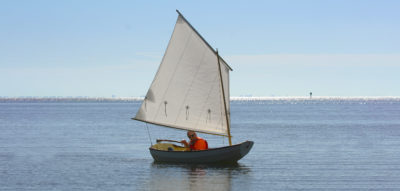


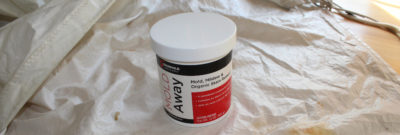
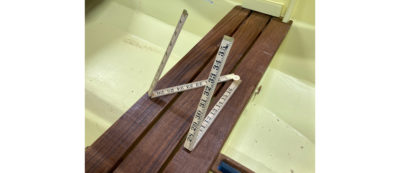

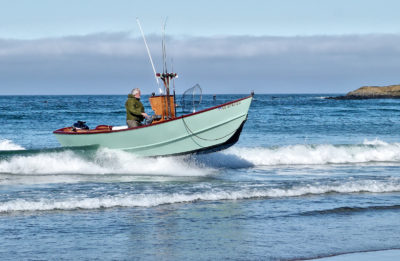
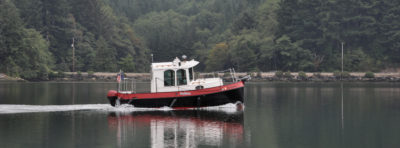

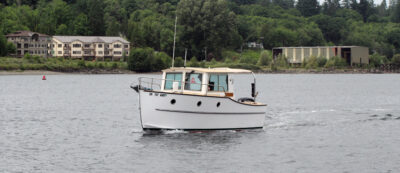
An interesting article, I’ve been fortunate enough to have followed the build of the Nutshell Praam EXCUSE ME via emails from Kent and Audrey (Skipper).
The build reminded me of the Yealm Praam that I built as a tender to the Wooden Drascombe Lugger SAGA. The Yealm Praam was scratch built without any plans at all, it was all done by eye and the length dictated by a standard 8ft x 4ft sheet of marine plywood. A nice varnished finish impressed the owner’s wife, who upon seeing it for the first time declared “It has a better finish than my sideboard.”
For those who may not know, Doug and his brother John built most of wooden Drascombes under licence from John Watkinson. It’s on my Bucket List to try and replicate a Yealm Praam with Doug’s approval and guidance.
Kent
Please feel free to have a go, but you’ll need to remember that I had no plans whatsoever, I don’t have any records of the measurements, not even the length and beam, apart from it being the maximum length that an 8′ x 4′ sheet of marine plywood allowed. I can of course provide a step by step process list and a good guess at the beam and freeboard.
Does the Nutshell pram need lofting to build?
Hi Richard
Full size patterns are included with the plans for the molds, transoms, forekeel and amidships keel. The 8 page plans have a sheet dedicated to plank layout that gives sufficient measurement points to trace and draw out the bottom and side planks. There is also a page with lines and offsets but we didn’t have to refer to that very much. Happy to answer any other questions that you may have.
Cheers
Skipper and Clark
If she’s anything like my Shellback, she’s a keeper. $3000 for the kit? A bit over the top.
Hi Rob
Yes, Fall 2022 prices are startling. Pandemic pricing increase due to logistics chain and workforce isolation issues was bad enough, now throw in the Russo-Ukranian war effect on the World economy. If memory serves correct the rowing kit was around $1750 pre-pandemic, not sure what the sailing kit was. In early 2022 we bought our high quality marine grade sapele plywood, mahogany and teak hardwood from World Panel in North Carolina, plus the Sailrite sail kit and paid close to $1500 in those purchases, including the 2-hour drive time each way to World Panel. 2×4 spruce for spars, and not the good stuff, is still almost double the pre-pandemic price. The kit will have the highest quality materials so the builder’s decision comes down to 1) whether quality materials can today be sourced locally for a significantly lower price and/or 2) Does the builder have the skill/tools to cut that expensive material?
Our advice for first time builders, not those who are already well versed in wood boat butchery like us, is to look closely at a kit purchase to flatten the learning curve.
Cheers
Clark and Skipper
An interesting bit of trivia, the design didn’t have a type name, but one of the first buyers named hers “Nutshell” because of the shape. It stuck.
I built mine from scratch. I had never built a boat before, nor even sailed, yet I was able to make it from the plans. Sometimes I felt I was out of my depth, particularly as all the measurements are in feet and inches, and in Australia we use the metric system and all materials are sold in metric. Other than that, I prevailed to a completed sailing version.
It’s a great little boat.
Phil Bolger designed at least one boat using metric measures. He advocated metric as a superior system. Do school kids trained in metric even need to learn fractions?
My favorite rowing boat. Thinking of the 12’ version, Passagemaker
I am curious about the sailing characteristics of the wood peanut class? I am not thinking of racing I am thinking of what happens in a capsize event from a novice sailor or a heavy wave from a passing motor boat?
Does the boat lie horizontal on the water or turtle? How much water is in the boat after righting?